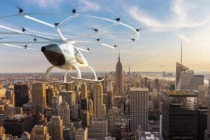Cool IoT use cases: Autonomous air taxis

Market overview
![]()
Autonomous flying transportation systems are an emerging market, one that must comply with very demanding national and international safety standards. German aviation startup Volocopter has trialed its 18-rotor urban air taxi in Dubai and the US and a series of tests are scheduled for the second half of 2019.
The Problem
![]()
As populations in cities continue to grow, the existing traffic situation will become increasingly demanding. Traffic congestion, emissions and extremely high costs for infrastructure are already pushing cities to their limits.
The Players
![]()
Volocopter, a leader in the development of electrical vertical takeoff and landing multicopters as autonomous air taxis for the safe transport of people. PTC, whose Windchill product lifecycle management (PLM) solution is being employed in the development of the autonomous air taxis.
The Solution
The Volocopter, which is based on drone technology, is emission-free, very quiet, and stable in flight. It has been designed to take two passengers on short automated flights within urban centers. The transportation concept is based on passengers going to a network of rooftop “Volo-ports”, climbing aboard and punching their destination into a tablet. Flight control software will then fly them up and over the congested streets.
![]()
The fully redundant power train is driven by 18 independently controlled propulsion rotors and managed by an intelligent, autonomous control system. The company says that the aircraft can cover around 30 km (17 miles) on each charge.
PTC’s Windchill is an end-to-end PLM platform that is IoT-ready. It allows companies to improve product quality by connecting teams directly to live operational data. It can also help reduce IT burden and overhead, while ensuring accessibility and security with both on-premise and cloud deployment options.
The solution was used to record, configure, and secure interdisciplinary product structures, requirements descriptions and documents, and manage mechanical, aerodynamic, and electronic CAD models and the associated system software. Windchill ensures rapid new development by amassing cross-company information at an early stage in the development, production, and testing processes.
Windchill, coupled with PTC’s ThingWorx Industrial Innovation Platform, will provide role-based applications to enable improved collaboration, as well as enable the imaging of digital twins to predict and test aircraft behavior in the physical world.
Business Benefits
![]()
- Mass transportation: goal is enabling take off and landing every 30 seconds
- Minimal impact on the environment
- Relieves the strain on congestion areas
- Fast connectivity to key connectivity to intersections like airports and business parks
Jobs for the update
- Employ next-generation battery technology
- Build a full, citywide system with partners
The author is freelance technology writer, Bob Emmerson.
Comment on this article below or via Twitter @IoTGN
